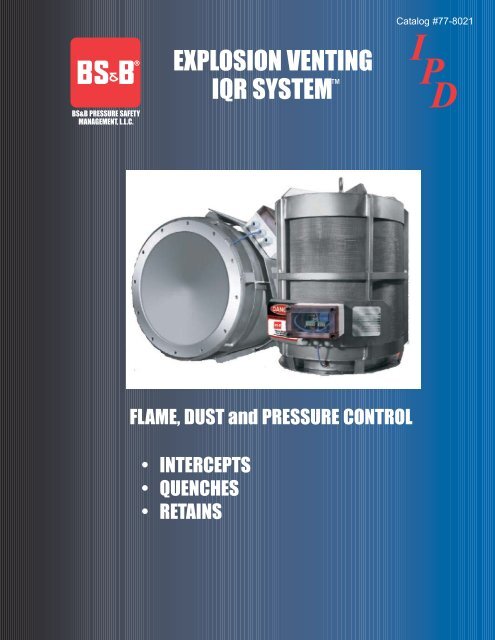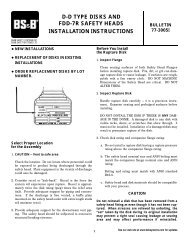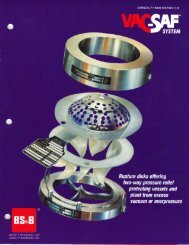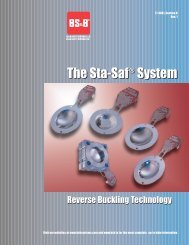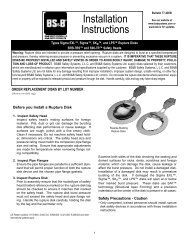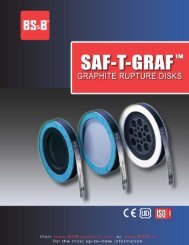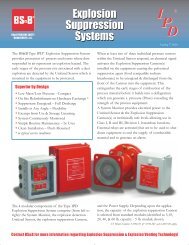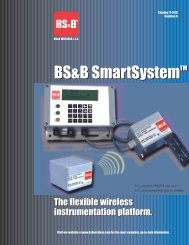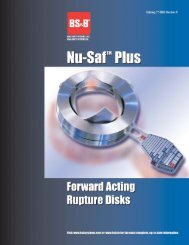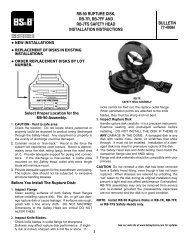EXPLOSION VENTING IQR SYSTEM - BS&B Safety Systems
EXPLOSION VENTING IQR SYSTEM - BS&B Safety Systems
EXPLOSION VENTING IQR SYSTEM - BS&B Safety Systems
Create successful ePaper yourself
Turn your PDF publications into a flip-book with our unique Google optimized e-Paper software.
Catalog #77-8021<br />
BS&B PRESSURE SAFETY<br />
MANAGEMENT, L.L.C.<br />
<strong>EXPLOSION</strong> <strong>VENTING</strong><br />
<strong>IQR</strong> <strong>SYSTEM</strong> <br />
I PD<br />
FLAME, DUST and PRESSURE CONTROL<br />
• INTERCEPTS<br />
• QUENCHES<br />
• RETAINS
4<br />
SAFETY<br />
FUNCTIONS OF THE<br />
<strong>IQR</strong> <strong>SYSTEM</strong><br />
<br />
Flame Arresting – No flame escapes providing a<br />
safe operating environment for personnel.<br />
Eliminates the possibility of a secondary ignition<br />
and subsequent explosion external to the protected<br />
equipment.<br />
Dust Retention – Retains process product removing<br />
the possibility of potentially toxic product entering<br />
the environment.<br />
Pressure Retention – Absorbs explosion pressure<br />
peak, protects personnel and surrounding environment<br />
from pressure blast.<br />
Temperature Control – Absorbs fireball with negligible<br />
temperature rise in surrounding environment.<br />
HOW THE <strong>IQR</strong> <strong>SYSTEM</strong> WORKS<br />
The <strong>IQR</strong> system comprises two parts, an explosion vent<br />
and a quenching module. The explosion vent responds<br />
to the rapidly building pressure of a deflagration and<br />
opens to relieve this pressure. As the developing fireball<br />
passes through the open explosion vent, it is intercepted<br />
by the quenching module. A stainless steel precision<br />
mesh, retained by a frame of stainless steel, performs as<br />
a 3-dimensional flame arrestor to quench the flame.<br />
The quenching module retains the flame and hot gases<br />
of a deflagration as well as the burning and<br />
unburned dust passing through the open explosion<br />
vent. The 3-dimensional mesh arrangement acts as a heat<br />
sink that interrupts the explosion in mid-stream as well<br />
as an absorption of the pressure wave and dust that<br />
would normally be ejected by a vented explosion.<br />
While the flameball temperature of a dust explosion<br />
can easily reach 500°C/ 932°F, the <strong>IQR</strong> quenching<br />
module typically remains below 100°C/212°F followed<br />
by rapid cool down due to its large surface area. This<br />
results in a negligible change in temperature in the environment<br />
surrounding the <strong>IQR</strong> System.<br />
With the quenching of flame, retention of dust,<br />
and control of pressure and temperature provided by<br />
the <strong>IQR</strong> system, this safety device may be applied<br />
indoors whenever the impact of a vented explosion<br />
must be avoided.<br />
APPLICATION OF THE <strong>IQR</strong> <strong>SYSTEM</strong> <br />
The <strong>IQR</strong> System is recognized as an explosion venting<br />
device by Codes and Standards such as NFPA 68,<br />
NFPA 654 and the European Atex Directive. The<br />
<strong>IQR</strong> System is a solution for the protection of<br />
process equipment installed indoors where one or<br />
more of the following conditions exist:<br />
• Venting to outside requires ducting that is too long.<br />
Vent ducting that exceeds 20ft/6m in length is not<br />
recommended — ducts up to 10ft/ 3m in length<br />
have the least impact on the pressure developed<br />
within the protected process equipment.<br />
• No space to install venting is available. This can<br />
arise where equipment is installed closely packed<br />
leaving no room for short and straight ducting.<br />
• No access is available to outside for vent ducting.<br />
This can arise where equipment is installed in<br />
basement areas as where no outside wall is present.<br />
• Release of fireball outside is unacceptable; a<br />
fireball might be ejected up to 100ft/ 30 meters<br />
and have 10 times the volume of the process<br />
equipment being protected.<br />
• Release of dust (burned and unburned) outside is<br />
unacceptable.<br />
• Release of explosion pressure pulse is unaccept<br />
able; adjacent building structures can be damaged<br />
by a pressure pulse that can exceed 2 or 3 psi over<br />
a large area for a short time.<br />
Many of these application concerns apply to outdoor<br />
process equipment as well. The <strong>IQR</strong> System may be<br />
applied to outdoor process equipment where precautions<br />
are taken to avoid buildup of snow, ice and water<br />
in the quenching module.<br />
Dust explosion without the <strong>IQR</strong> System<br />
Dust explosion with the <strong>IQR</strong> System
<strong>IQR</strong> <strong>SYSTEM</strong> <br />
TYPICAL FAST RESPONSE TIMELINE<br />
Zero<br />
Seconds.......Explosion ignition.<br />
0.015<br />
Seconds.......Pressure builds.<br />
0.025<br />
Seconds.....Vent opens at low pressure.<br />
0.055<br />
Seconds.......Fireball builds within Quench Module.<br />
0.075<br />
Seconds.......Fireball quenched which interrupts Combustion Process.<br />
0.090<br />
Seconds......Peak Pressure develops within protected equipment<br />
and is absorbed by Quench Module.<br />
0.125<br />
Seconds<br />
0.165<br />
Seconds<br />
0.200<br />
Seconds......Combustion Process ending. Dust detained by<br />
Quench Module.<br />
0.275<br />
Seconds<br />
0.350<br />
Seconds<br />
0.425<br />
Seconds<br />
0.500<br />
Seconds.....Combustion ends. Quench Module already cooling.<br />
INFORMATION REQUIRED TO SPECIFY THE <strong>IQR</strong> <strong>SYSTEM</strong><br />
The <strong>IQR</strong> System is an explosion venting device. The<br />
following information is required to select and specify<br />
the correct <strong>IQR</strong> unit for your application.<br />
Process Dust (Kst and Pmax)<br />
Process Equipment Description (Volume(s));<br />
preferably drawings including inlet and outlet<br />
connections.<br />
Normal operating pressure and temperature<br />
Protection pressure for process equipment<br />
(Pred)<br />
Should this information be unavailable, let BS&B’s<br />
technical sales personnel review your application with you.
METRIC UNITS<br />
Type<br />
I.D.<br />
mm<br />
H<br />
mm<br />
A<br />
mm<br />
mm B<br />
mm AR<br />
mm<br />
BC<br />
d<br />
mm n #<br />
wt.<br />
Kg<br />
<strong>IQR</strong>-8 208 560 360 430 269 243 8.5 8 29<br />
<strong>IQR</strong>-12 310 560 460 530 391 355 11 12 34<br />
<strong>IQR</strong>-16 393 940 560 630 500 443 13 16 55<br />
<strong>IQR</strong>-20 494 940 660 740 599 544 13 20 69<br />
<strong>IQR</strong>-24 596 1400 770 860 701 646 13 20 144<br />
<strong>IQR</strong>-28 697 1910 880 970 800 752 13 28 224<br />
<strong>IQR</strong>-32 799 2210 980 1070 899 854 13 28 275<br />
H-(max)<br />
Type<br />
I.D.<br />
in.<br />
U.S. CUSTOMARY UNITS<br />
H<br />
in.<br />
A<br />
in.<br />
B<br />
in.<br />
AR<br />
in.<br />
BC<br />
in.<br />
d n wt.<br />
in. # lbs.<br />
<strong>IQR</strong>-8 8.2 22 14.2 17 10.6 9.6 0.33 8 64<br />
<strong>IQR</strong>-12 12.2 22 18.1 20.9 15.4 14 0.43 12 75<br />
<strong>IQR</strong>-16 15.5 37 22 24.8 19.7 17.4 0.51 16 121<br />
<strong>IQR</strong>-20 19.4 37 26 29.1 23.6 21.4 0.51 20 152<br />
<strong>IQR</strong>-24 23.5 55 30.3 33.9 27.6 25.4 0.51 20 317<br />
<strong>IQR</strong>-28 27.4 75.2 34.6 38.2 31.5 29.6 0.51 28 494<br />
<strong>IQR</strong>-32 31.5 87 38.6 42.1 35.4 33.7 0.51 28 606<br />
Dimension A is the external diameter of the <strong>IQR</strong> unit.<br />
I.D.<br />
BC - (0)<br />
AR - (0)<br />
B - (max)<br />
1. Explosion vent with integral<br />
Burst Alert ® Sensor<br />
2. <strong>IQR</strong> Monitor that provides signal<br />
upon activation for process shut down.<br />
3. Eyebolts for lifting and support<br />
after installation (if required)<br />
Connection Flange<br />
number (n) and diameter<br />
(d) of bolt holes (see table)<br />
INSTALLATION, INSPECTION AND MAINTENANCE<br />
The <strong>IQR</strong> System is simply installed by a bolted<br />
flange connection at its inlet, just as an explosion<br />
vent would by applied. Installation may be in any<br />
convenient location.<br />
In the case of larger size <strong>IQR</strong> devices or where<br />
installed to weak equipment, additional bracing may<br />
be required by connecting to the eyebolts supplied<br />
with each <strong>IQR</strong> unit. The <strong>IQR</strong> system is always<br />
supplied with an integral Burst Alert® sensor and<br />
monitor circuit that will generate an alarm signal<br />
when the device activates. Codes require that this<br />
alarm signal be used to shut down the process to<br />
stop the feed of dust and air which are the fuel for<br />
an explosion.<br />
Annual inspection of the <strong>IQR</strong> system is recommended<br />
by factory trained personnel. While the <strong>IQR</strong> is a passive<br />
safety device, just like an explosion vent, periodic inspection<br />
ensures optimum safety.<br />
Factory trained personnel are available for assistance with<br />
commissioning as well as annual inspection. Forthcoming<br />
changes to codes and standards require that both passive<br />
and active safety systems be subject to periodic inspection. The<br />
<strong>IQR</strong> system has no routine maintenance requirements.<br />
Commissioning and annual inspections will identify any<br />
planned maintenance requirements unique to each<br />
application.<br />
After system activation there is minimal external cleanup<br />
compared to an open vented dust explosion. The <strong>IQR</strong><br />
System can typically be refurbished after activation for<br />
quick and economic process restart.<br />
BS&B Pressure <strong>Safety</strong><br />
Management, L.L.C.<br />
BS&B Pressure <strong>Safety</strong> Management, L.L.C.<br />
7422 East 46th Street, Tulsa, OK 74145, USA<br />
Phone: 1-918-622-5950<br />
Fax: 1-918-665-3904<br />
Toll Free: 1-800-272-3475<br />
sales@bsbsystems.com<br />
www.bsbipd.com<br />
Products, specifications and all data in this literature are subject to change without notice.<br />
Questions regarding product selection and specifications for specific applications should be<br />
directed to BS&B Pressure <strong>Safety</strong> Management, L.L.C.<br />
Contact BS&B for more information regarding Explosion Isolation, Explosion<br />
Suppression & Explosion Venting technology. BS&B Type IPD Explosion<br />
Suppression <strong>Systems</strong> are FM approved. All sales are subject to BS&B Pressure<br />
<strong>Safety</strong> Management, L.L.C. or standard terms and conditions of sale.


